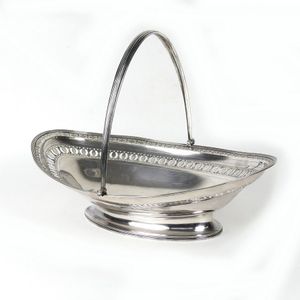Georgian Silver Bread Basket with Neoclassical Design
You must be a subscriber, and be logged in to view price and dealer details.
Subscribe Now to view actual auction price for this item
When you subscribe, you have the option of setting the currency in which to display prices to $Au, $US, $NZ or Stg.
- Bread Basket - Bread baskets were commonly used from the 17th to the 19th centuries in Europe and America as a serving piece at formal meals. In the early 17th century, bread baskets were made of wood, pewter and later silver as it was an expensive and prestigious material and demonstrated off the host?s wealth and status.
These bread baskets were usually oval or circular in shape, and were typically decorated with intricate engravings, embossing, and other decorative details. Some were plain and simple, while others were quite ornate, featuring raised scrollwork, beading, or other decorative motifs. Those made in the early 17th century tend to have two handles but surviving examples are rare. From the mid 1770s they usually have a central swing handle. The handles were typically ornate and often curved or scrolled. The shape and size of these baskets varies; some are large, meant to hold multiple loaves, others are more compact and meant for one loaf. By the 18th century, most bread baskets were made of silver. - Georgian - As an English stylistic period, Georgian is usually taken to cover the period from George I (1714) to the Regency of Prince George (1811-20), although the period from 1800 to 1830 is sometimes designated as the Regency period. During the Georgian period the great English cabinetmakers and designers such as Chippendale, Hepplewhite, Adam Sheraton etc., were all active.
Therefore there isn't a single 'Georgian style' as such and to say something is 'Georgian', usually means it was made between 1714 and 1830. This assumes we discount George V and George VI, both being from the 20th century.
The styles popular at the time of each reign were:
George I (1714-1727) saw out the last years of the Baroque period.
George II (1727-1760) reigned during the Rococo period.
George III (1760-1820) saw the last gasp of the Rococo, all of the early Neo-Classic 'Adam style' and most of the later neo-Classic 'Regency style'.
George IV (Prince Regent 1820-1830)encompassed the last of the 'Regency' style.
William IV's reign (1830-1837) was something of a no man's land (stylistically) and he wasn't a 'George' anyway. He covered the last glimmerings of 'Regency' and the start of the 'Victorian' style.
This item has been included into following indexes:
- baskets, silver, period or age
- baskets, silver, type - bread 27
Visually similar items

A diamond single-stone ring, the princess-cut diamond, weighing 2.12 carats, within a four-claw setting, mounted in platinum, ring size M . Accompanied by a report from the Gemological Institute of America (GIA) stating that the diamond is E colour, VS2 cl

A Georg Jensen sterling silver oval handled bowl, model No 235C, circa 1930, crowned mark. 7.5 cm wide, 6 cm high, 50 grams

A Danish silver bangle, Hans Hansen, designed by Bent Gabrielsen. 925 silver. Weight 63.63 grams. Inside diameter 6 cm.

Platinum and diamond 'Corona' ring, Bulgari, 2008, modelled as a wishbone, accented at intervals with seven round brilliant-cut diamonds together weighing 0.15 carats, size K1/2, Italian maker's marks, signed Bulgari. Accompanied by Bulgari papers and box
